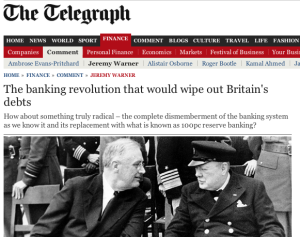The banking revolution that would wipe out Britain’s debts


How about something truly radical – the complete dismemberment of the banking system as we know it and its replacement with what is known as 100pc reserve banking?, asks Jeremy Warner in his article in the Telegraph on 7th June 2013.
He writes:
‘This is not as ludicrous a suggestion as is sometimes made out. What’s more, to describe it as radical may be a bit of a misnomer. Actually, 100pc reserve banking is a distinctly “conservative” approach to the problem, for its primary purpose is to make finance as low risk as possible.
Nor is it the completely unrealistic, fringe idea sometimes supposed, having been treated very seriously by President Franklin D Roosevelt during the last great banking crisis in the 1930s, when it was quite widely supported by some of the leading economic thinkers of the time.’
…
‘To understand how such a system would work, you have to go back to first principles. By extending credit, bankers create money. Few of them admit to this dynamic, and certainly, for the individual banker operating at the coal face of credit allocation, it doesn’t look that way. Every time a banker makes a loan, he must fund it with deposits and capital. Where’s the money creation in that’
He then explains how new money is created and what limits the process of money creation: “The only limits on this process of money creation are the banker’s instinctive fear of making a bad loan…” He describes how this has led to credit bubbles and banking crisis and also how money gets destroyed and money supply shrinks when the confidence of banks collapses:
‘It is at this stage of the credit cycle that the process of money creation goes violently into reverse. As the bank shrinks its balance sheet by calling in loans, it destroys deposits with the same vigour it created them on the way up.’
He continues in describing the benefits of 100% reserve banking: no risk of a bank run, elimination of credit cycle and the too-big-to-fail problem, no need for deposit insurance, reduction of debt etc.
Then Jeremy expresses his concerns with 100% reserve banking though:
‘When something looks too good to be true, it generally is. One of the most obvious drawbacks is that there would plainly be less credit and less leverage in such a system. Indeed, to the extent that credit existed, it would look much more like high-risk equity. For all the social and economic scarring the credit cycle can inflict, it is also a key part of the creative destruction of capitalism.
The biggest problem of all with 100pc reserve banking is that of transition. Getting from here to there would be a truly revolutionary and potentially highly destabilising process, so much so that it is hard to think of any advanced economy embarking on it.’
You can read the whole article here.
It’s great to see the media openly writing about ‘where money comes from’ more and more today. And it’s great they are finally discovering reform proposals which aim to change the way how money is created.
Proposal by Kumhof & Benes from IMF is just one of more variations of similar proposals. It is the most known since it was published as IMF working paper. But there are other proposals which also deal in detail with the concerns Jeremy raised. One of them is Positive Money reform proposal.
The aims of both Benes-Kumhof Chicago Plan and the Positive Money proposal are the same: namely to prevent banks from creating money in the process of making loans, while returning the power to create money to the state. However, while the aims are the same, the methods by which the aims are achieved vary considerably.
A detailed explanation of the Positive Money reforms is available in the book MODERNISING MONEY.
It describes in detail how will be ensured that banks will be able to provide adequate credit immediately after the switchover and it also covers the transition process between the current and reformed monetary systems – the problems Jeremy was concerned about in the article.
A brief plain English description of the proposals is available here.
We hope that Jeremy and other journalists can see the enormous potential benefits of these proposals and it will inspire them to explore this further.